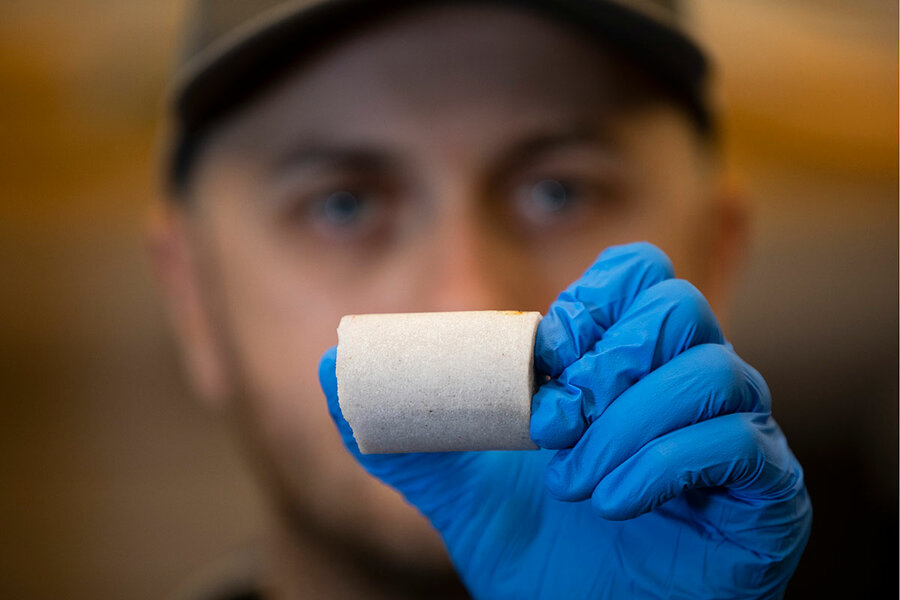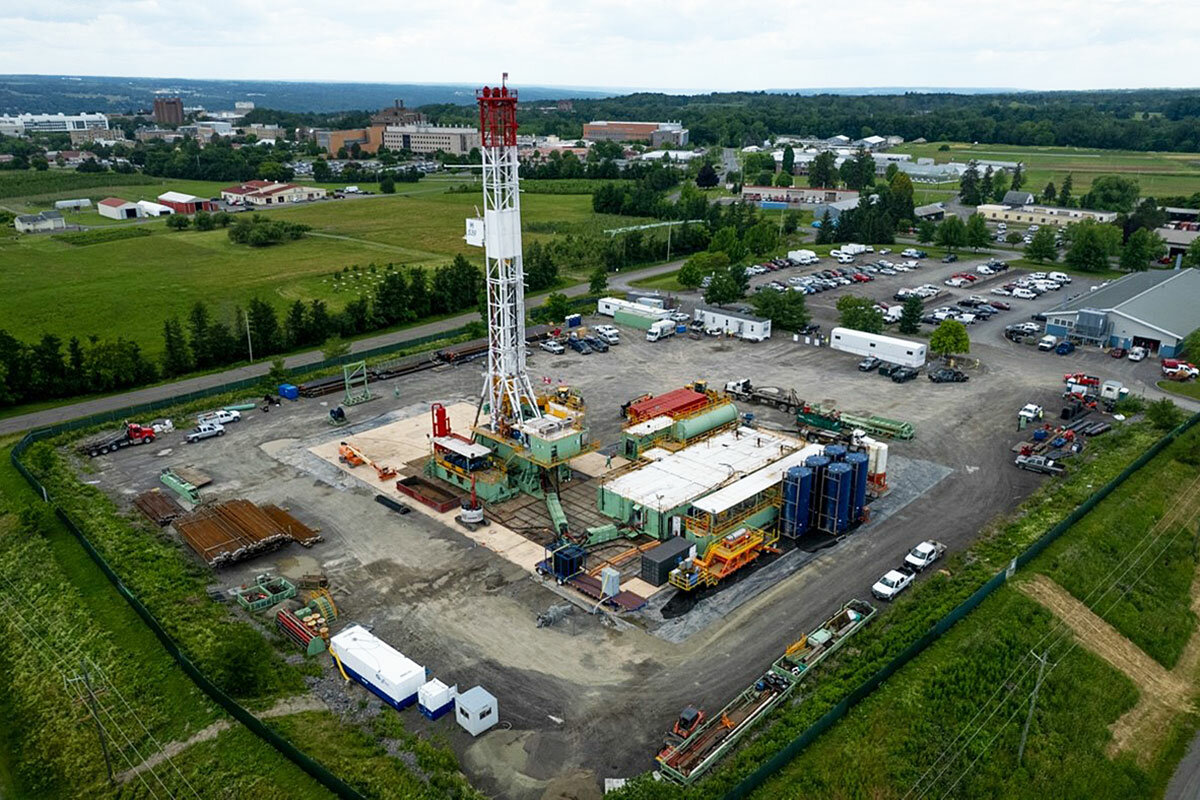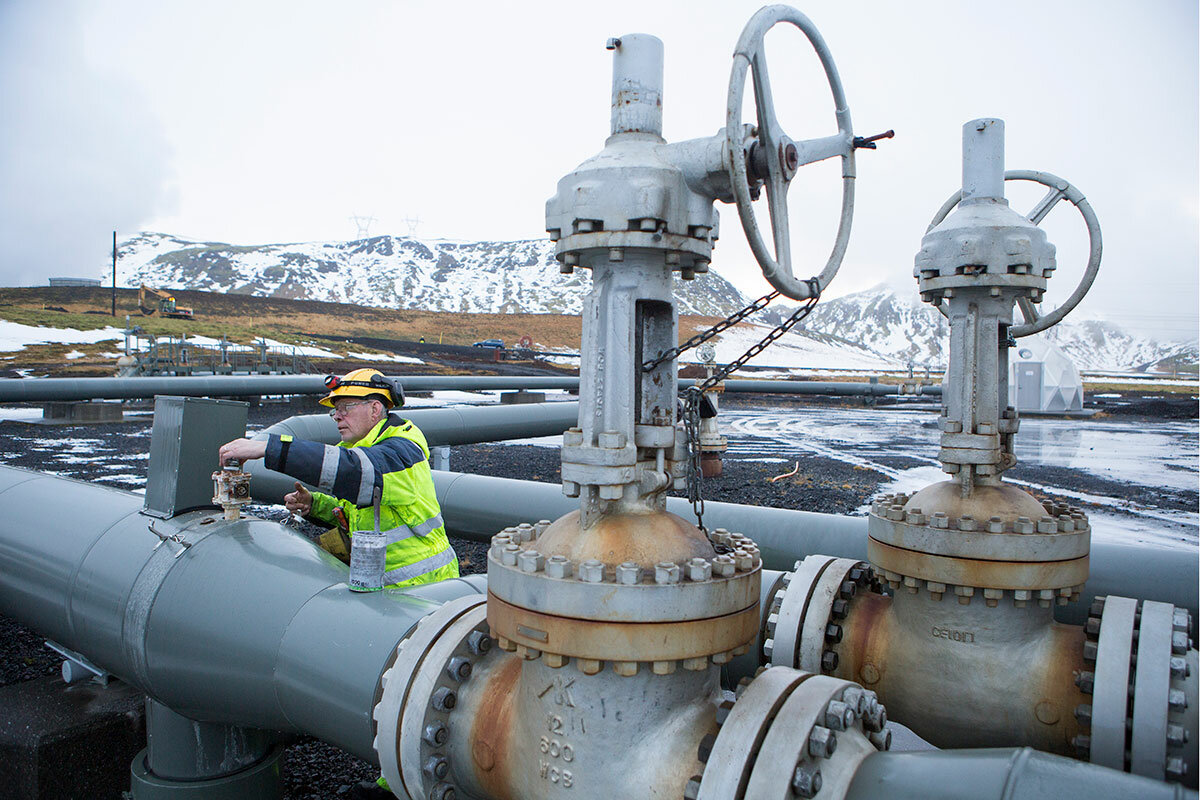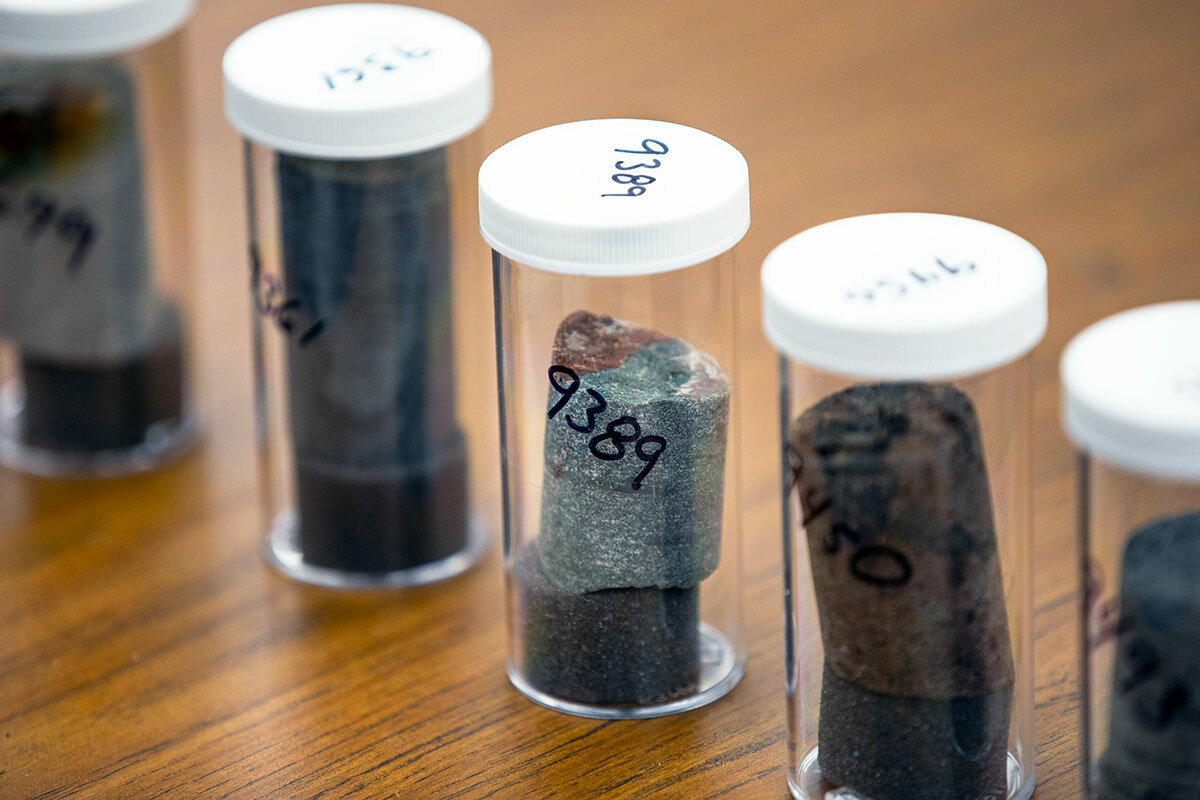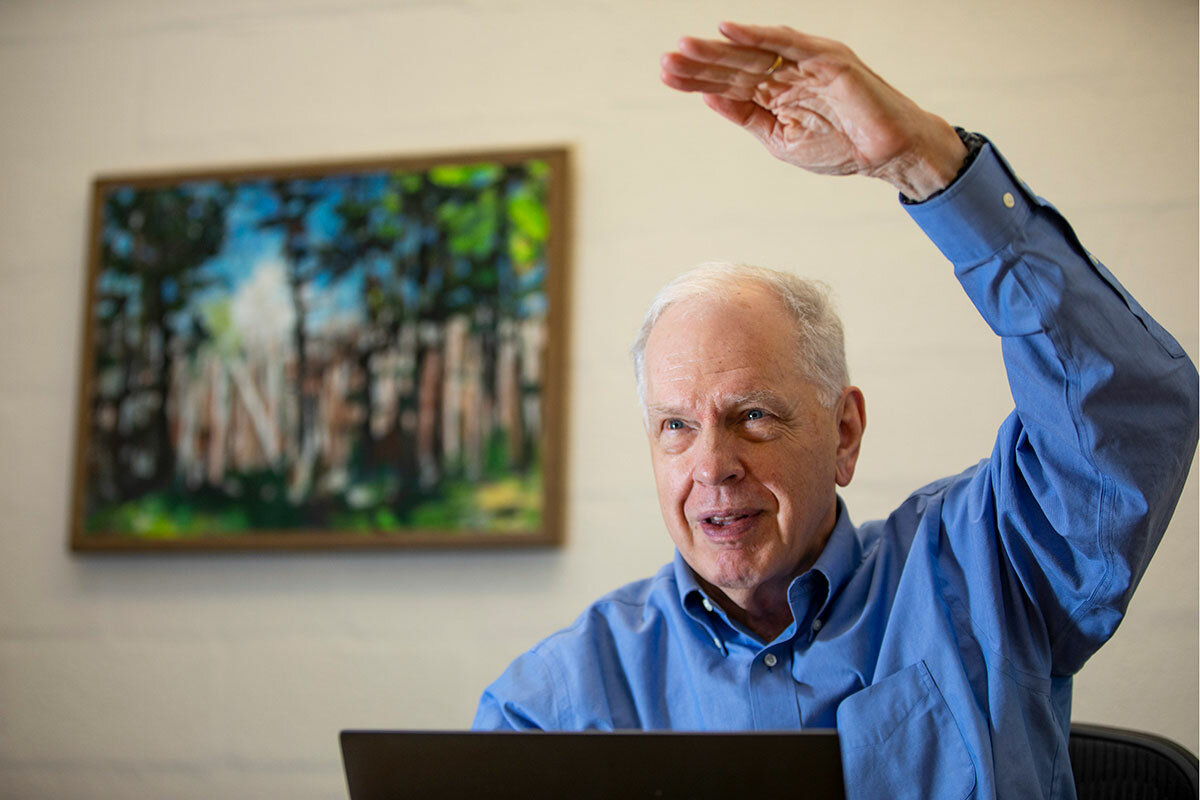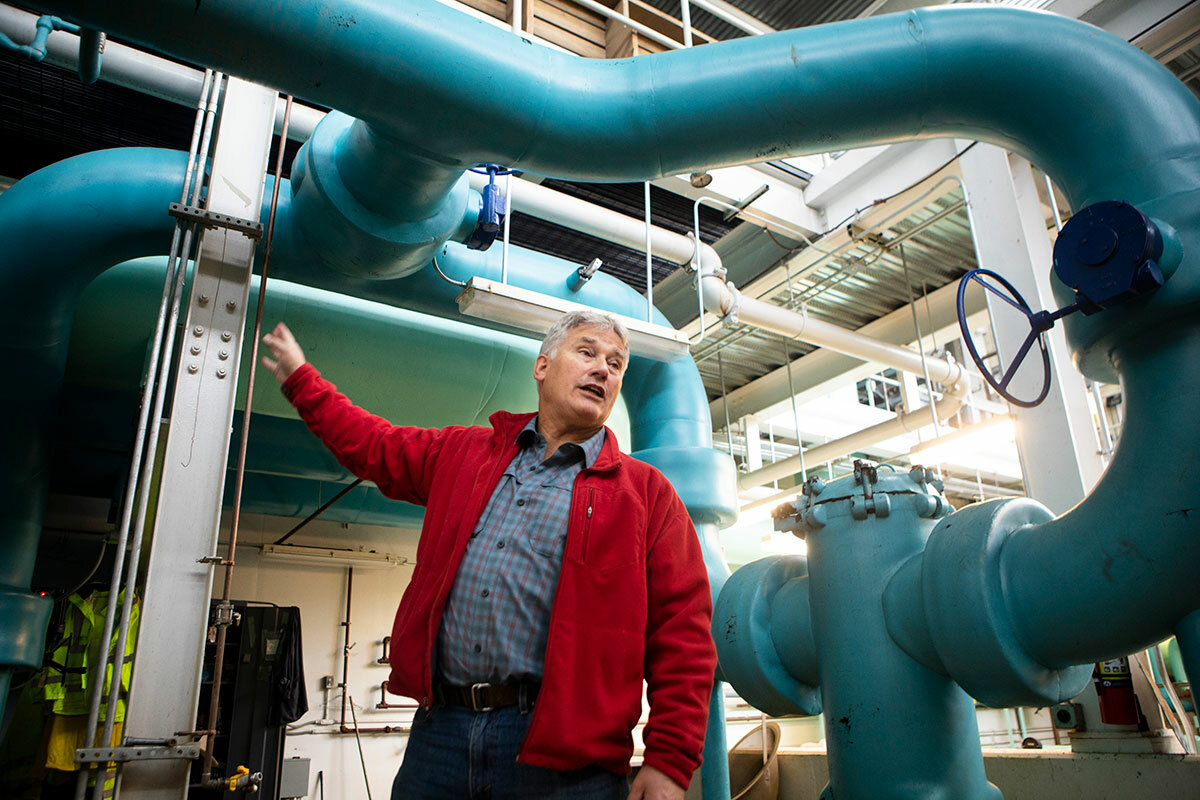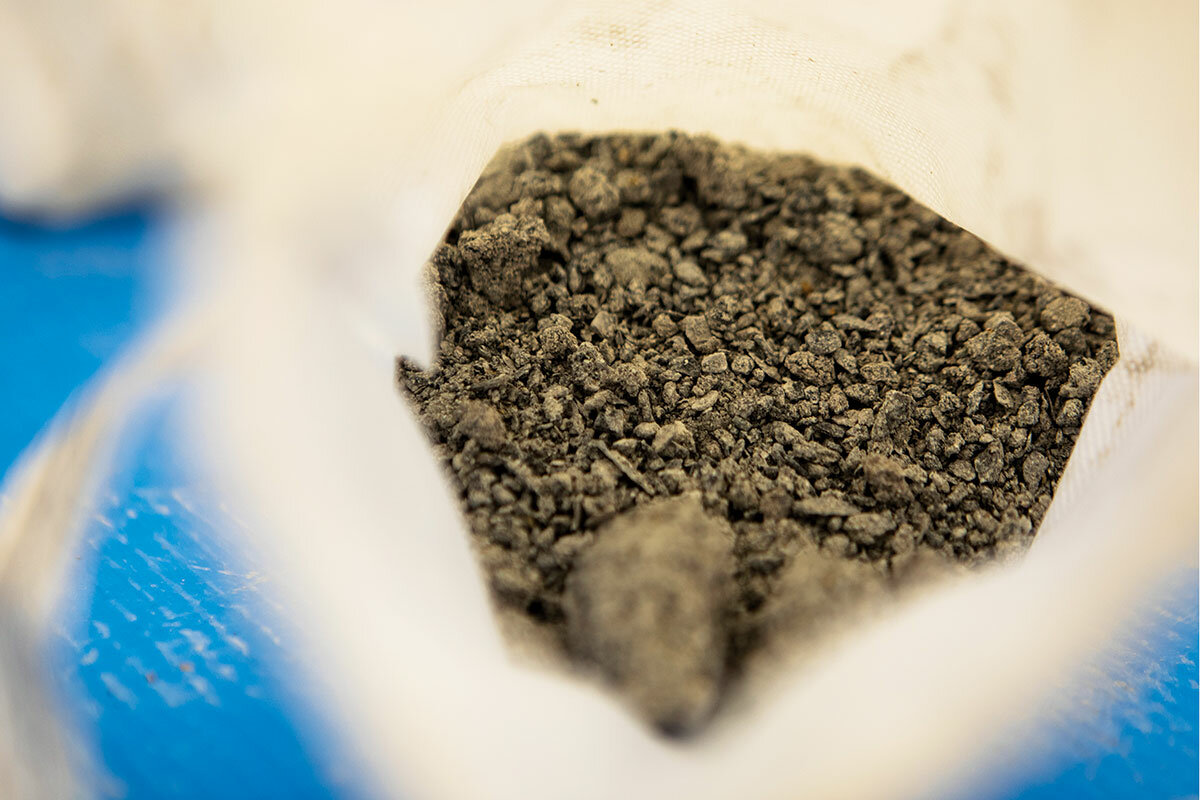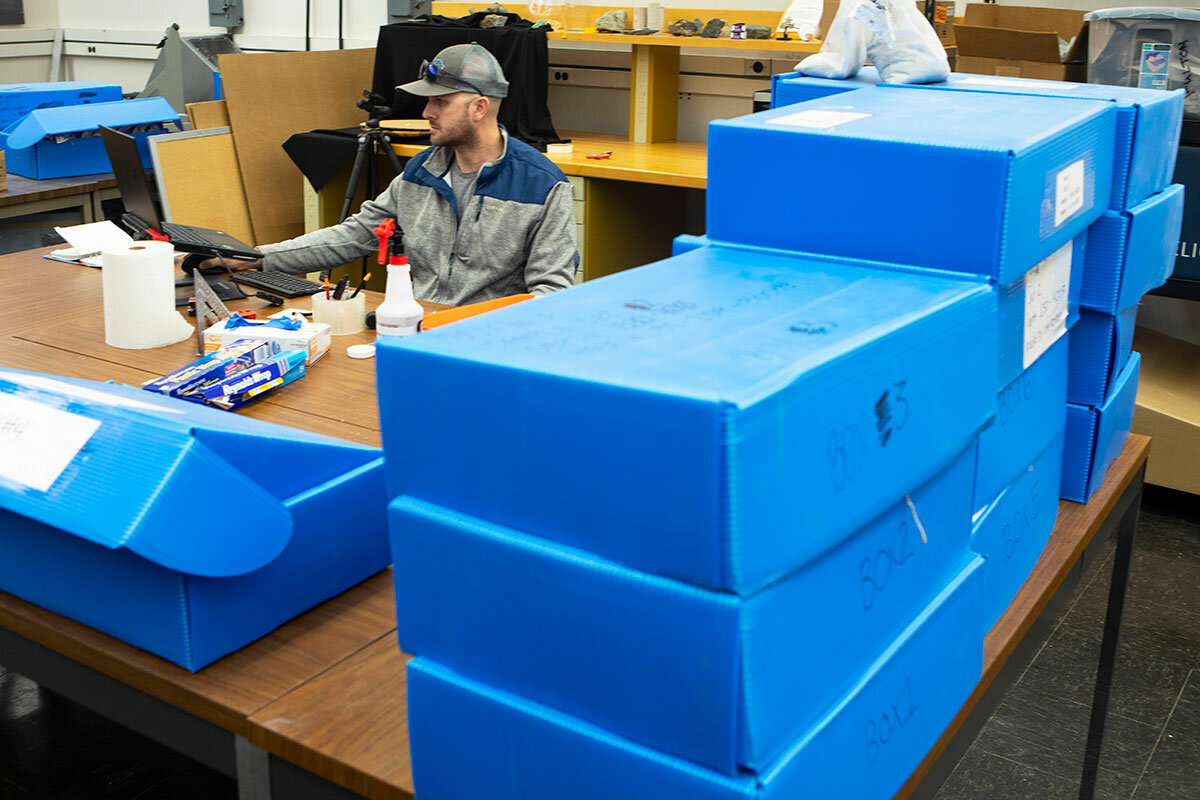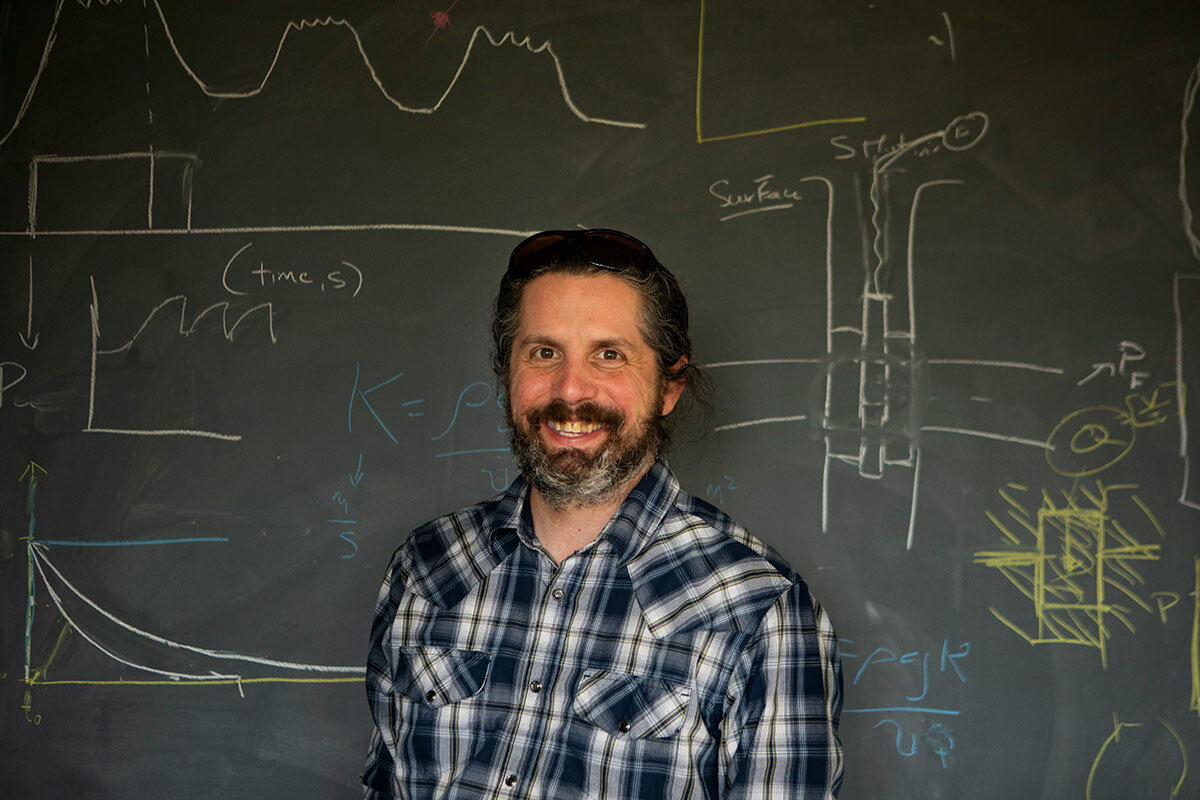Geothermal 2.0: Why Cornell University put a 2-mile hole in the Earth
Loading...
| Ithaca, N.Y.
Most of the discussion about how to stay warm without burning fossil fuels has focused on electrification – exchanging your oil tank, for instance, for an electric heat pump. But this approach doesn’t solve a big problem: where that electricity comes from. Despite a huge increase in wind and solar power production, most electricity still comes from power plants that burn fossil fuels.
Nuclear, solar, and wind all partly offer solutions to this.
Why We Wrote This
A story focused onTo solve humanity’s reliance on fossil fuels, solar and wind power isn’t enough. Some researchers and investors are looking down, not up. Our reporter finds ingenuity powering new efforts to produce heat and electricity by tapping the Earth’s core.
But below a nondescript former parking lot in Ithaca, New York, scientists at Cornell University are trying something else: drilling a hole 2 miles into the Earth.
Geothermal energy is not new. In Iceland, where hot rock and subterranean water are near the surface, 9 out of 10 households get their heat directly from geothermal sources. But the current moment of climate concerns, energy prices, and new financial incentives has sparked a new sort of Earth rush, even in places where the geography for geothermal energy is less obvious.
Some of the new players entering the field are those deeply familiar with drilling: oil and gas majors.
“It’s changing the mindset,” says Patrick Fulton, one of the lead geothermal researchers at Cornell. “It is starting to think more sustainably about how we interact with the Earth.”
The Cornell University campus in Ithaca, New York, is a small city of some 30,000 people, spanning 2,400 acres and hundreds of buildings, including castlelike dorms and state-of-the-art laboratories, an art museum shaped like a sewing machine, and a power plant that produces some 240 megawatts of electricity every year.
This leafy, academic metropolis is perched on layers of sedimentary rock – geology that reveals itself in the gorges that slice through the campus, deep crevices where, long ago, errant waters of retreating glaciers ripped open the earth.
These layers continue deep underground, thousands upon thousands of feet, until they hit what is known as the “crystalline basement.” There, nearly 2 miles down, lies a rock barrier between what we, as humans, typically think of as “earth” on one side, and the planet’s hot, silicate mantle on the other. It also marks the location of what a growing cadre of scientists, entrepreneurs, and government officials sees as a viable solution to a pressing, yet elemental, challenge: how to stay warm.
Why We Wrote This
A story focused onTo solve humanity’s reliance on fossil fuels, solar and wind power isn’t enough. Some researchers and investors are looking down, not up. Our reporter finds ingenuity powering new efforts to produce heat and electricity by tapping the Earth’s core.
On the one hand, this might seem like a mundane problem for the intellectual and technical ingenuity of one of the world’s top research universities. Humanoid ancestors, after all, solved this problem of winter centuries ago with their fires and blankets and animal skins. Today, central heating systems have made staying warm almost an afterthought, even in those Northern Hemisphere locations that freeze for months on end.
But there is a looming problem: How we heat mostly relies on burning fossil fuels. This is a problem because of what it means for the world’s climate, which is changing rapidly thanks to atmosphere-warming emissions. But it is also a problem because it is becoming clear that staying warm through winter is tied to global forces often beyond one’s control, such as Russia’s invasion of Ukraine, which has resulted in both gas shortages and cost spikes.
This situation, a growing number of researchers say, is requiring a new sort of ingenuity. Until very recently, most of the discussion about moving away from fossil fuel-based heating has focused on electrification – exchanging your oil tank, for instance, for an electric heat pump. But this approach, although effective at lowering greenhouse gases, doesn’t address two big problems: First, the world’s electric grids are already straining to keep up with demand. And second, despite a huge increase in wind and solar power production, most electricity still comes from power plants that burn fossil fuels.
Policymakers have suggested a slew of different models for addressing this quandary, such as extending the life of nuclear power plants, ramping up the number of wind and solar farms, or tapping into the awesome power of ocean waves to produce electricity.
But here in Ithaca, and in a rapidly growing number of locations worldwide, scientists, utilities, and entrepreneurs are flipping the solutions narrative. Instead of looking upward for clean energy, to the sun or the wind, they are turning their ingenuity downward, into the Earth itself. And while the basic concept of geothermal energy has existed for decades – if not centuries, depending on how one looks at it – the current moment of climate concerns, energy prices, and new financial incentives has sparked a new sort of Earth rush.
“We’re seeing a huge influx into the geothermal sector,” says Jeremy Harrell, chief strategy officer at ClearPath, a research and advocacy group that focuses on using free-market policies to accelerate emissions reductions. “Geothermal is exciting. It’s a cost-effective technology that is resilient and that can provide heat and power.”
It could also, if some of the more cutting-edge initiatives succeed, fundamentally alter the way the world understands and uses energy.
In the middle of a nondescript gravel lot, once reserved for contractor parking, high above Cayuga Lake, researchers involved with Cornell’s Earth Source Heat project have drilled down nearly 2 miles, to that crystalline basement, to explore the potential of tapping geothermal heat. Only the wellhead remains – the drill rig and the mud spinners and cement silos departed this fall – but scientists here are still studying the geology of what they affectionately call CUBO, the Cornell University Borehole Observatory. They are modeling water flow, examining seismic behavior, and working with facilities staff to plan a new system for heating the campus.
“If we want to decarbonize, we have to switch from natural gas to something else,” says Jefferson Tester, a professor of sustainable energy systems in Cornell’s Smith School of Chemical and Biomolecular Engineering and the principal scientist for the university’s Earth Source Heat project. “Geothermal would be one of the really good opportunities. ... It’s on all the time, it’s available, it’s stored in the earth. And we can reach it with today’s technology. We’re trying to give an example of what you could do, and what we might have to do.”
Tapping the earth for heat and power, by itself, is not new. In Iceland, where hot rock and subterranean water are near the surface, 9 out of 10 households get their heat directly from geothermal sources. In Boise, Idaho, a centralized geothermal system delivers 177-degree water through a series of pipes that heats millions of square feet of downtown building space. There is also geothermal heating in Paris; San Bernardino, California; and Klamath Falls, Oregon – places where subterranean hot water reservoirs can flow through rock at relatively shallow depths.
These places also tend to have geothermal power plants – facilities that use the Earth’s heat to make steam to spin turbines that generate electricity in the same manner as nuclear or coal plants. The Geysers, for instance, a 45-square mile facility located about 75 miles north of San Francisco, is home to the largest geothermal energy site in the world. This spot, which archaeological research shows was a human gathering place for centuries, has some 300 production wells and 69 miles of injection piping feeding steam into turbines that in turn supply a good percentage of California’s renewable energy – about 8% in 2021. This power, points out Joseph Greco, the head of the Western region strategic initiatives for Calpine, the company that runs the Geysers, is consistent – it doesn’t fluctuate like wind or solar. This is particularly important for a grid that is increasingly maxed out. During the state’s rolling blackouts this past summer, “we were there supplying the grid 24/7,” he says.
But the idea of expanding geothermal anywhere and everywhere, so that the earth beneath one’s feet can take care of a good percentage of one’s own heat and power needs – that’s new. And it has caught the imagination not just of scientists, but of the U.S. Department of Energy, along with a growing number of startups and existing power companies.
“There are not a lot of places in the world that you just have steam billowing out of the ground,” says Paul Thomsen, vice president of business development at Ormat Technologies, a Reno, Nevada-based geothermal company that is rapidly expanding operations. “So you have to start drilling and looking for hidden geothermal resources. And with innovation, the concept is that we don’t have to have Old Faithful to develop geothermal.”
There are different systems for creating this “next-generation” geothermal. There are “closed-loop” systems that, rather than tapping into hot underground water reservoirs, send a pipe through the hot areas, sort of like a big, old-fashioned radiator through the Earth.
In areas without deep water reservoirs – a geology that those involved with geothermal will sometimes call “hot dry rock” – there are also efforts to “frack” deep rock, making fissures through which water can be injected. (Those involved with geothermal insist this is fundamentally different from much-protested natural gas fracking, since they are using only water to break up and run through the Earth, not sand and chemicals.)
Ormat Technologies uses a geothermal system where hot underground brine – water that is filled with salt and other sorts of minerals – heats a secondary liquid, which in turn goes through a heat exchange process to spin power-generating turbines. The company now has an energy portfolio that includes facilities across the world, from the U.S. to Kenya to Indonesia.
But starting a geothermal project takes time. Those involved with geothermal say that the permitting process is cumbersome, often requiring a yearslong feasibility and safety ramp-up. It is location specific, since the type of well and how deep it goes into the Earth change a lot with the geologic composition of any particular place. (This is unlike, say, solar panels, which can be mass produced and installed in almost any location.) And it is not easy to drill deep into the Earth.
But there is an existing industry with a lot of experience in geology and drilling. And with growing political, financial, and climate pressures, it has an interest in diversifying its operations. This, of course, is the oil and gas sector.
Many executives in that industry are now looking at alternatives, says Maria Richards, the Geothermal Lab coordinator at Southern Methodist University in Dallas.
“With the start of COVID [when demand dropped] ... it has seemed to create a push for [the] oil and gas industry to pause and say, we need to look outside the box,” she says. “There will be a time in the future when people do not need or want all this oil and gas.”
She and many others involved with geothermal caution that there are important nuances that differentiate oil and gas drilling from mining Earth heat. But there’s no disputing that there are key similarities. There are a growing number of private sector geothermal initiatives staffed by former fossil fuel workers, and sometimes backed by oil and gas companies themselves. And to go with this, there is growing venture capital investment.
This summer, a company named Fervo Energy raised $138 million for next-generation geothermal energy, the largest private investment in geothermal technology to date. Much of Fervo’s leadership comes from the gas and oil sector. The Alberta No. 1 geothermal project in Canada explicitly advertises its background in drilling and gas exploration – its name is a nod to Leduc No. 1, the site of Alberta’s major oil discovery in 1947.
Catherine Hickson, the CEO of the Alberta No. 1 geothermal energy project, knows that there has been excitement about geothermal in the past. She has worked for more than 40 years in the sector, primarily as a scientist for the Canadian government, and she watched as government and private investor attention turned toward geothermal during global oil crises and then shifted back to fossil fuels. Even today, she says, it’s hard for geothermal to compete financially against the gas and oil sector – if one is going to dig a very deep and expensive hole, there’s still a lot more money to be made bringing up fossil fuels as opposed to hot water.
But all of that is shifting with climate change, she says, and as companies worry about the sustainability of their business models in the face of what is turning into a global consensus on the need to reduce greenhouse gas emissions significantly and quickly.
“We want to make sure people understand that our form of renewable energy has a very significant environmental credit to it,” she says. “We think it’s very important from the perspective of greenhouse gas reduction. And financially, carbon credits and ESG [environmental, social, and governance] have dramatically changed the landscape for geothermal.”
Others are working on technology to further reduce the cost of geothermal. Paul Woskov, for instance, a professor at the Massachusetts Institute of Technology (MIT), has turned his expertise in nuclear fusion technology toward making a new sort of drill that uses gyrotron beams to vaporize rock. If he and the company attempting to commercialize his work are successful, they hope to dramatically lower drilling costs – and allow for geothermal to happen everywhere.
“Our principle is that we’ll be able to replace every fossil fuel plant with a geothermal plant,” he says.
To encourage this sort of innovation, the U.S. Department of Energy this year added an enhanced geothermal “shot” to its Energy Earthshots program, a series of initiatives and funding streams intended to spark innovation to help address the climate crisis and grow the clean energy job sector. The department made a specific request for projects that used geothermal for direct heat.
“Everybody is talking about electrification, but I don’t think electricity is the answer,” says Dr. Hickson at Alberta No. 1. “We need to get the world to understand – especially in the U.S. and Canada – the low-hanging fruit here is thermal energy.”
This has been Dr. Tester’s mission for decades.
The Cornell professor began working in geothermal energy as a postdoctoral student in Los Alamos, New Mexico, under the Carter administration, when scientists at the national laboratory began what became known as the Hot Dry Rock Program.
Their goal was not dissimilar to that of today’s geothermal entrepreneurs, although futuristic at the time. “The natural heat in hot dry rock at accessible drilling depths is one of the largest supplies of usable energy that is available to man,” wrote Los Alamos scientist Morton Smith in a 1995 report about the program. “It is potentially capable of satisfying the world’s total energy needs for thousands of years.”
But the funding for that program evaporated during the Reagan administration, and Dr. Tester went to work at MIT, where he continued his research on geothermal energy and heat. In 2009, Cornell asked him to join its faculty and head a project to put that work into practice.
In many ways, Cornell’s Ithaca campus was the perfect location to create an earth source heat system. It was already committed to carbon neutrality. And from a practical point of view, a university, where administrators have access to and control over all the buildings, is a good place to make this sort of systemwide change.
Cornell had already made huge investments in both practical science and infrastructure related to utilities, and it had a suite of alternative energy systems: a central heat and electricity power plant that was converted from burning coal to cleaner natural gas and now tracks and adjusts its operations to keep emissions as low as possible; a generations-old hydropower plant perched alongside the picturesque Fall Creek; and, most unusually, an innovative “lake source cooling” system, which taps the cold, deep water of Cayuga Lake to cool buildings without traditional air-conditioning systems. That lake source cooling, in fact, was the same system that Dr. Tester imagined for heat, just in reverse – a water-based, centralized pipe system that operates with minimal electricity and, thanks to connected solar panels and the hydroelectric plant, almost no carbon. Meanwhile, administrators were aware that heating accounted for more than a third of the school’s total greenhouse gas emissions.
The school was also willing to experiment. It is part of the university’s mission, administrators say, to use academic resources
to develop environmental solutions that can be applied well beyond campus. “The way we can move the needle is finding new solutions,” says Sarah Carson, director of Cornell’s campus sustainability office. “And what’s really special about our geology is that there is nothing special about our geology.”
In 2009, Dr. Tester and his team of graduate students began putting together a plan for the new Earth Source Heat system.
But in many ways, what was under their feet was still a mystery.
“We can make guesses about what rocks are there,” says Patrick Fulton, an earth and atmospheric sciences professor at Cornell and one of the lead Earth Source Heat researchers with Dr. Tester. “There are seismic and geophysical surveys that can help us predict it. But to know what it actually is – for that we have to go down.”
In a windowless laboratory on the first floor of the Cornell University earth sciences building, dozens of blue boxes sit on top of each other, all filled with samples of earth taken from CUBO. Graduate student Sean Fulcher removes one baggie and dumps the contents onto a table. The gravel shards are part of the crystalline basement, which Mr. Fulcher and Dr. Fulton estimate to be 1.1 billion to 1.5 billion years old. The rocks were likely part of the base of a mountain range that once reached higher than the Himalayas.
They extracted these samples from the borehole. The scientists are now exploring each of them, cleaning them, painstakingly recording their features, and building a 3D image of the inside of the Earth. These rocks, and others, give a sort of map of what may be underneath the university – where there are cracks, where geologic layers have pushed into one another, where tectonic movement from 100 million years ago may have left the sort of subterranean features that today could lead to a modern-day heating system.
Some of this research is also essential for safety. “You don’t want to mess around and create earthquakes,” Dr. Fulton says.
This has happened with some geothermal initiatives in the past. In 2009, for instance, the Swiss government abandoned plans for geothermal power after the project generated unexpected seismic activity that damaged homes in the city of Basel.
Closer to Cornell, in Onondaga land south of Syracuse, the Tully Valley mud boils are the continued, polluting legacy of an 1800s attempt to mine salt by injecting water into the ground. The earth fractures created by that process still, more than a century later, allow brine laden with silt and minerals to boil toward the surface, muddying what was once the fishing grounds of the Onondaga people.
This worries some environmentalists, who wonder about the line between ingenuity and hubris – especially with a growing number of private sector interests involved. But geothermal researchers say the alternative of continued fossil fuel emissions is even riskier, and they insist that there is far more attention today to the possible seismic and environmental impacts of drilling.
“There are definitely things that, if you don’t do it well or smart, and you don’t have an understanding of what could go wrong, then could be bad,” says Dr. Fulton.
That’s why an academic effort like Cornell’s is so important, he and others involved say. They are not only demonstrating the viability of a new energy system, but also showing how to foster ingenuity safely. They are working to fully understand the rocks before continuing with the next phase of the project, which would involve drilling more wells and connecting the geothermal system into the campus’s existing heating system. Those involved say the project could still take years to complete, depending on financing.
But for Dr. Fulton, the purpose of CUBO goes beyond simply heating the campus with carbon-free thermal energy. Knowing what is underground helps scientists imagine a relationship with the Earth that is not simply extractive, he says. If humans, for instance, are taking heat from those deep rocks, could we return that energy? Could the Cornell greenhouses, which currently blow heat into the atmosphere, instead send that heat underground, using the Earth as a sort of rechargeable heat battery?
“It’s changing the mindset,” he says. “It is starting to think more sustainably about how we interact with the Earth.”




